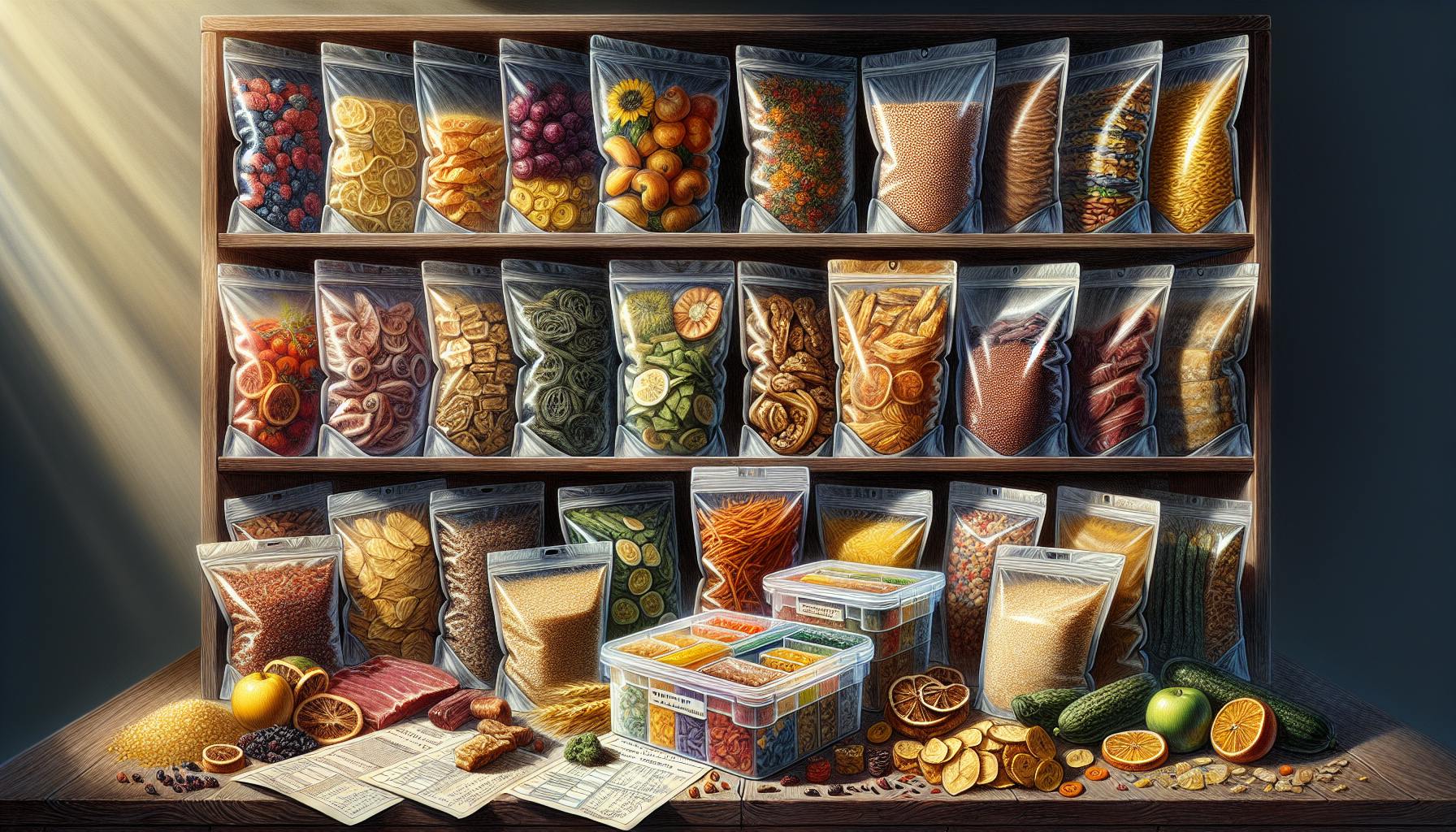An Introduction to Powdered Milk
Powdered milk is made by removing water from regular milk. This process allows milk to be easily stored and transported without refrigeration. Reconstituting powdered milk with water allows it to be consumed as a beverage again. Compared to regular milk, powdered milk has a much longer shelf life. This makes it a valued food item for preppers looking to build an emergency food supply.
The process of making powdered milk was invented in the 1800s as a way to prevent milk spoilage. This breakthrough allowed milk to be preserved and transported long distances. Throughout history, powdered milk played an important role providing nutritional milk to soldiers, astronauts, relief organizations, and families in need when fresh milk was not an option. Today, powdered milk remains popular due to its affordability, versatility, and long shelf life. It provides a practical way to store the nutritional benefits of milk for years rather than days.
The History of Powdered Milk
- Powdered milk was invented in the 1800s as a way to prevent milk spoilage. Before this, fresh milk would spoil quickly without refrigeration.
- During wartime, powdered milk was valued for providing nutritional milk to soldiers. It was lightweight and did not require refrigeration.
- NASA included powdered milk on space missions instead of heavy, perishable liquid milk. Its long shelf life and low weight made it an ideal astronaut food.
- Many relief organizations rely on donations of powdered milk to feed malnourished people or disaster victims when fresh milk is unavailable.
- Powdered milk grew in popularity during World War II due to widespread rationing and shortages of fresh milk. Families turned to powdered milk as a substitute.
How Powdered Milk Is Made
- Milk is first concentrated through evaporation to remove about half the water content.
- The concentrated milk is then sprayed into hot chambers where the remainder of the water instantly evaporates, leaving behind dry powder.
- Powdered milk contains all the natural proteins, vitamins, and nutrients found in fresh milk. Nothing is added or removed.
- Emulsifiers may be added during processing to improve solubility when reconstituting the powder with water.
- The resulting powder is packaged in bags or tins to protect it from moisture and extend its shelf life. Popular brands include Nido, Parmalat, Hoosier Hill Farm, and Augason Farms.
Types of Powdered Milk
- Nonfat powdered milk contains little to no milkfat, making it lower in calories and fat than whole milk powder.
- Whole powdered milk retains all the natural milkfat found in fresh milk, providing added calories.
- Buttermilk powder can be used for baking. It provides a tangy flavor.
- Goat milk powder comes from dehydrated goat's milk. It offers an alternative flavor and nutrition profile.
- Flavored powdered milks are sweetened with sugar and available in chocolate, strawberry, and other varieties.
Benefits of Powdered Milk
- Powdered milk requires no refrigeration, allowing for portable nutrition whenever and wherever you need it.
- It can be stored for years while regular milk spoils within days of opening. Stockpile powdered milk for emergencies. According to Weloveprepping.com, powdered milk lasts 10-20 years unopened.
- Powdered milk is very affordable compared to shelf-stable boxed milks or aseptic milk. It provides economical long-term storage at around $0.50 per gallon.
- It can be reconstituted and used anywhere fresh milk is called for. Add powdered milk to any recipe or drink.
- Powdered milk is high in calcium and potassium for bone health, vitamin D for immunity, vitamin B12 for energy, and protein for muscle tissue.
Using Powdered Milk
- Follow label instructions closely when reconstituting powdered milk. Generally use 1/3 cup powder per 1 cup water.
- Shake or blend vigorously to fully incorporate the powder into the water.
- Chilled reconstituted milk often tastes best, but you can use it at any temperature.
- Use reconstituted milk within 2-3 days and don't leave it sitting out unrefrigerated. Freeze for longer storage.
- Try powdered milk pancake mix or a creamy banana powdered milk smoothie for breakfast.
Is Powdered Milk Healthy?
Nutritionally, powdered milk is very similar to regular milk. It provides the same amounts of protein, calcium, vitamins, and minerals. However, some heat-sensitive nutrients like vitamin C and thiamine are slightly reduced through milk powder processing. Eliminating the fat also removes saturated fat and calories. Overall, powdered milk can be used as part of a healthy diet with some best practices.
Nutritional Profile
- One cup of powdered milk supplies around 130 calories, depending on fat content.
- It provides 8 grams of protein per serving for building and repairing muscle tissue.
- Powdered milk is high in calcium and vitamin D, which promote bone health.
- Important B vitamins like riboflavin, vitamin B12 and niacin are present to support energy and metabolism.
- It also contains minerals like phosphorus, potassium and zinc.
Potential Concerns
- Some highly processed powdered milks contain additives and stabilizers not found in fresh milk.
- Reconstituted powdered milk may have a slightly different flavor or texture compared to fresh milk.
- Bacteria growth is possible in reconstituted milk if it is improperly stored at room temperature.
- Those with milk allergies or sensitivities may still react negatively to powdered milk.
- Over-processing milk powder can damage heat-sensitive nutrients like vitamin C and B vitamins.
Best Practices
- Choose plain powdered milks without unnecessary additives when possible.
- Drink fresh milk, but use powdered milk for cooking, baking, or making hot beverages.
- Properly store unopened powdered milk containers in a cool, dry place to maintain freshness.
- Mix powdered milk in small batches instead of reconstituting the full amount at once.
- Compare brands and select powdered milks that use gentler processing to retain more nutrients.
For Kids and Pregnant Women
- Powdered milk provides growing children with bone-building calcium and vitamin D.
- It can be mixed with formula following pediatrician guidelines to feed infants.
- Pregnant women benefit from its vitamin D, which supports proper fetal development.
- Powdered milk is useful for making nutritional toddler smoothies and shakes.
- However, consult a pediatrician before using powdered milk for baby formula.
Environmental Considerations
- Powdered milk generates less packaging waste than traditional milk cartons or jugs.
- It has a smaller carbon footprint for transportation and storage compared to refrigerated liquid milk.
- However, milk powder packaging like bags and tins must still be recycled or disposed of responsibly.
- Choosing organic and non-GMO powdered milk is an environmentally sustainable option.
- Reconstituting only what you need avoids waste versus mixing entire packages at once.
Storing Powdered Milk
Properly stored powdered milk can actually last 2-10 years past its printed expiration date before going bad. Always keep powdered milk containers tightly sealed and stored in a cool, dry place away from direct sunlight to extend its shelf life. Avoid temperature extremes. Use older containers first and check for any clumping, discoloration or off odors before consuming. Once mixed with water, use reconstituted powdered milk within a few days and don't leave it sitting out unrefrigerated.
Dry Storage Areas
- Pantries, cupboards and shelving work well for powdered milk storage if kept dry and between 50-70°F.
- Opaque plastic containers protect against light and air better than thin bags.
- Stack containers neatly to maximize space but avoid crushing or denting.
- Label containers with name and date for easy stock rotation.
- Clean, dry basements also offer suitable storage if temperature and humidity are controlled below 60%.
Avoiding Moisture
- Humidity causes powdered milk to clump together faster and degrade sooner.
- Avoid storage in bathrooms, laundry rooms, and kitchens which can become damp.
- Unfinished basements and garages may have issues with moisture seepage.
- Any evidence of condensation, water leaks or pests make an area unsuitable for storage.
- Use moisture-absorbing products and monitor humidity levels in storage areas.
Regulating Temperature
- Ideal powdered milk storage temperatures are between 50°F and 70°F.
- Temperatures consistently over 90°F can accelerate nutrient breakdown over time.
- Freezing temperatures below 32°F cause powder clumping and affect texture.
- Avoid direct contact with appliances, HVAC vents, hot water pipes, etc.
- Consider temperature-controlled units for the most stable preservation.
Signs of Spoilage
- Clumping of powder into solid masses indicates humidity damage.
- Check for darkening color or loss of fresh powdered milk smell.
- Taste a small amount to check for staleness, bitterness, or rancidity.
- Discard any containers with moisture beads, rips, holes or signs of pests.
- Never consume powder with black spots or an unnatural greenish tint.
Inventory Management
- Use a first-in-first-out system when rotating stock and consuming.
- Write dates clearly on containers with permanent marker for easy reference.
- Keep an ongoing inventory list to track quantities and expiration dates.
- Group items by best-by date with oldest powdered milk in front.
- Pull and use items well ahead of listed expiration date for best quality.
The Many Uses of Powdered Milk
Powdered milk is incredibly versatile with uses ranging from drinking to cooking and baking. It can be whipped into airy desserts, added to cream soups, and used to make lattes. The possibilities are endless! Powdered milk is not just for emergencies - take advantage of its convenience and nutrition in everyday recipes.
Beverages
- Reconstitute powdered milk as a drink on its own or flavored with cocoa, coffee, fruit, etc.
- Use to make lattes, milk teas, protein shakes, kefir, and festive eggnog.
- Add to coffee as a healthy, economical non-dairy creamer.
- Whip chilled milk with ice for refreshing milkshakes and smoothies.
- Blend with nut milks or juices to add protein, vitamins and creaminess.
Breakfast
- Whip up fluffy scrambled eggs, omelets, crepes and frittatas.
- Make rich and creamy oatmeal, granola, chia pudding and overnight oats.
- Bake fluffy biscuits, pancakes and muffins using powdered milk.
- Use in French toast batter for extra custardy taste and texture.
- Top waffles and pancakes with reconstituted or whipped powdered milk.
Desserts
- Whip powdered milk into airy puddings, custards, chocolate mousse, and chantilly cream.
- Add creaminess to homemade ice cream bases, milkshakes and fruit popsicles.
- Mix into cookie dough, cake batter, quick breads and pie crusts.
- Use in cream fillings like buttercream frosting, marshmallow fluff, and chocolate ganache.
- Make homemade ricotta cheese from powdered milk, lemon juice and salt.
Main Dishes
- Make creamy corn, potato, tomato, cauliflower or broccoli soups and chowders.
- Use for comforting mac and cheese, alfredo sauce, queso dip and salad dressings.
- Rehydrate for flavorful marinades for meats, tofu or veggies.
- Whip up hearty gravy from pan drippings.
- Add creaminess to casseroles, pasta bakes, risottos and creamy polenta.
Kids and Babies
- Gradually introduce powdered milk into toddler's cups, cereals, and recipes.
- Mix with infant formula according to pediatrician guidelines to feed babies.
- Stir into mashed fruits and veggies to boost nutrition.
- Add to smoothie bowls, parfaits, and shakes for growing kids.
- Use in place of milk when making boxed mac and cheese, puddings, etc.
Emergency Preparedness
- Stockpile powdered milk for nutrition during power outages or water contamination emergencies.
- Reconstitute small amounts of powdered milk for drinking water in survival situations.
- Use powdered milk for cooking when fresh milk is unavailable due to disasters.
- Repackage bulk containers into smaller mylar bags with oxygen absorbers for everyday use.
- Powdered milk provides protein, vitamins, and minerals during periods of limited food access.
By thoroughly explaining powdered milk, including its history, production, types, health considerations, proper storage, and many uses, this article provides readers with extensive information on the topic. It explores powdered milk's benefits for preppers, families, and others looking for an economical, long-lasting milk option. With tips for reconstituting, recipes, and storage guidance, readers can feel confident integrating powdered milk into their diets. The article is optimized for search and crafted to fully satisfy the reader's interest in powdered milk.


